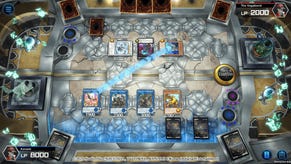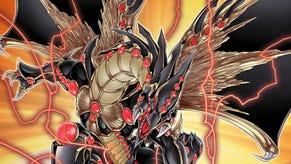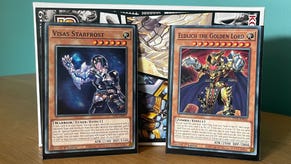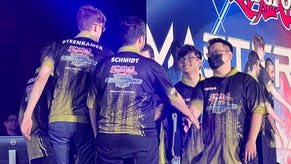6 best Photon Hypernova cards in Yu-Gi-Oh!’s latest booster set
Kashtira rules everything around me.
As players continue to integrate cards from the latest core booster set for the Yu-Gi-Oh! TCG into their decks, the answer to questions on the best Photon Hypernova cards leads all player's minds to one particular archetype: Kashtira.
Best Photon Hypernova cards in Yu-Gi-Oh!
- Galaxy Photon Dragon
- Gold Pride - Leon
- Gravekeeper’s Inscription
- Triple Tactics Thrust
- Tri-Brigade Arms Bucephalus II
- Kashtira Riseheart, Kashtira Arise-Heart, Pressured Planet Wraitsoth and all of the new Kashtira cards
This latest set is headlined by its all-new support for the Galaxy and Photon support, with an all-new C number card in the archetype named Number C62: Neo Galaxy-Eyes Prime Photon Dragon serving as a headliner for the set. Yet ever since the set released in the Japanese market towards the end of last year, the near-instant transformation of Kashtira from an archetype with strong potential that found a home as an engine within many Tearlaments player’s decks into a top tier deck in its own right through powerful new support cards left players eager to get their hands on the cards for themselves.
The release of Photon Hypernova finally offers those excited fans their chance to play around with this new array of support. It’s no doubt these are by far the most anticipated cards of the set, and some of the best. This new booster pack has far more to offer than just Kashtira, though, with support for players of all types of decks and archetypes and even an all-new World Premiere racing archetype. Some of which may run under the radar amidst the excitement.
Check out our rundown of the best Photon Hypernova cards to come out of the freshly-released booster pack.
1. Galaxy Photon Dragon
A Pho-ton of potential

True to the name of the set, Photon Hypernova feels like a revitalisation of the Galaxy and Photon archetypes thanks to the new support offered in this release. While I doubt we’ll be seeing the deck receive major competitive play going forwards, it’s cards like Galaxy Photon Dragon that help bring the deck new life to those dedicated players in the current meta.
This Xyz monster’s strength is as a utility searcher for any Photon or Galaxy card in your deck, adding it to your hand or sending it to the graveyard. One thing holding back the deck in prior incarnations was the difficulty faced in getting the right cards into position in order to bring out your top-draw Galaxy-Eyes Xyz monsters like Number 90: Galaxy-Eyes Photon Lord and Galaxy-Eyes Cypher X Dragon. The ability to search any monster and - if a Light monster is special-summoned - free rein to augment its level as needed is just the effect needed to massively improve this beloved archetype’s consistency.
2. Gold Pride - Leon
First place!

Gold Pride is the new world premiere archetype available with the international release of Photon Hypernova. What makes the archetype powerful is its gimmick that comes into effect whenever your effects are lower than your opponent. In these circumstances, these fast-racing riders gain the ability to special summon themselves from your hand, on top of their effects when summoned and on the field. Retaining lower life points than your opponent is key to racing over the finish line in first place.
Of all the cards introduced in this first wave, it is Leon that is perhaps the most important to unlocking the deck’s full potential. After special summoning itself from your hand, you can target another non-Warrior Gold Pride in your Graveyard to Special Summon, instantly setting up either Xyz or, since the Warriors are Tuners, Synchro summons. To win with Gold Pride, utilising the strength of Leon is key.
3. Gravekeeper’s Inscription
This one's a keeper!

On the other end of the spectrum, Gravekeeper’s Inscription is about frustrating your opponent, slowing them down or even completely preventing them from countering your own star plays. True to the Gravekeeper archetype these negation effects are indiscriminate, and it is this limitation that will likely prevent some decks like Tearlaments, whose strategy relies on activating effects in the graveyard, from running this deck. For those who can take advantage, however, it proves a perfect counter for much of Yu-Gi-Oh!’s current metagame.
Activated at the start of your Main Phase 1, Gravekeeper’s Inscription allows players to choose to either prevent the activation of card effects, the ability to banish cards or special summon monsters from the graveyard until the end of your opponent’s turn. It’s a continuous negation that has the power to stop some decks completely in their tracks until the effect is limited. That alone makes this a powerful threat in the current game (and a highly-sought Secret Rare).
4. Triple Tactics Thrust
Triple trouble

Similar to how Triple Tactics Talent went from a limited-use spell to a key tactical spell powerhouse, Thrust promises to offer a similarly-disruptive effect on the game through its power of search.
Monster effects are ever-present in the modern Yu-Gi-Oh! metagame, making any cards that activate with the condition of monster effects pretty versatile. What Thrust offers to this equation is incredibly-useful searching capabilities, allowing the player to search for any Normal spell or trap card from the deck provided your opponent has activated a monster effect. The generic nature of the card leaves it capable of being splashed into any deck to search crucial cards, and can even counter hand traps by offering a +1 even if they stop your initial strategy.
Not even a limitation preventing it being activated that turn can hold this card back.
5. Tri-Brigade Arms Bucephalus II
Armed and dangerous

Ban lists and new archetypes countering Tri-Brigade may have hurt the deck in recent months, but Tri-Brigade Arms Bucephalus II is hoping to change that. While its 3+ monster summoning requirement on a Link-5 combined with a need for three or more Tri-Brigade Spell and Trap cards in your graveyard make it a difficult card to summon, provided you can bring this Winged Beast out, it will be difficult for any opponent to overcome.
As long as Tri-Brigade Arms Bucephalus II is on the field, your opponent can’t activate cards or effects to any monster you special summon. It’s possible to banish this card to banish all cards on your opponent’s field whenever any monster declares an attack. And if this card is sent to the graveyard, you can send a Tri-Brigade monster from your Extra Deck to the graveyard, setting you up for the next onslaught. If the match is enough in your favour to bring the card into play, it’s hard to picture your opponent clasping victory from the jaws of defeat.
6. Kashtira Riseheart, Kashtira Arise-Heart, Pressured Planet Wraitsoth and all of the new Kashtira cards
The dawn of a new Kasht-era

It’s one thing to bring up all these cards from Photon Hypernova with the versatility to be splashed in many decks or offer the strength necessary to elevate their archetype to the next level… but as we noted at the start of this list, there is one archetype everyone has their eyes on with this latest set - and that’s Kashtira.
The Kashtira archetype is centred primarily around banishing cards from your opponent face-down while locking them out of combating your board by preventing them from using their monster, spell and trap cards through the effect of Kashtira Shangri-Ira. Shangri-Ira was released in Darkwing Blast and while face-up can block zones on the field each time an opponent’s card is banished, plus it can be protected from destruction by detaching materials.
What much of this new support offers is a way to activate this zone-blocking effect more often and more consistently, and quickly bring out Shangri-Ira and other board-ruining monsters. Take Kashtira Wildheart. Although a Level 4 in a deck revolving around Level 7 Xyz monsters, Riseheart is easily special summoned when another Kashtira is on the field - a condition easily achieved with searchers like the new field spell Pressured Planet Wraitsoth, which can call either Unicorn or Fenrir who can be special summoned provided you control no monsters.
Provided it was normal or special summoned, Riseheart can then banish a Kashtira in deck to banish three cards from the top of your opponent’s deck facedown before increasing its level to 7. If Shangri-Ira was already on the field? Congratulations, you just blocked one of their zones. If it wasn’t? You now have a level 7 Kashtira to bring it right out.
That is, if you don’t just choose to bring out the new Xyz, Arise-Heart. While it does require three Level 7 Monsters to bring out, it can also be summoned with just one Kashtira if the effect of Shangri-Ira was activated that turn successfully. Now, any card sent to the graveyard is banished (albeit not facedown), while endlessly gaining new materials once per chain if a card is banished by attaching it to the card. If that wasn’t enough, you can detach three materials once per turn to banish a card on the field face down, making it near-impossible to retrieve.
Suddenly, with an all-new searcher, a flexible banisher like Riseheart and a new Xyz in Arise-Heart that, unlike Shangri-Ira, can be an offensive force with 3000 ATK, it’s understandable why the Kashtira deck was so hotly anticipated before Photon Hypernova’s release. This is before discussing cards like Kashtiratheosis, which can help to special summon new Kashtira monsters from your deck that are a different attribute to the one targeted by this effect upon activation, while gaining an additional effect to add a banished Kashtira (except Kashtiratheosis) to hand if Kashtiratheosis is banished. Which now, thanks to cards like Arise-Heart, became even easier.
It’s hard not to come out of Photon Hypernova recognising just how strong this set is, whether you play Kashtira or one of the many archetypes that can benefit from new generic staples or support. Already the set is impacting the metagame with the meteoric rise of Kashtira, but its full impact on the meta is one that will only become more pronounced as time passes. Welcome to Yu-Gi-Oh in 2023!









